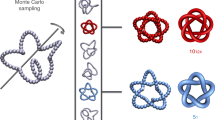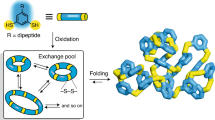Abstract
Synthetic applications of chemical ternplates have yielded, in succession, macrocycles, cage compounds, interlocking rings and a trefoil knot. The known kinds of templates are analyzed and used to provide a broad definition of a chemical template, which, in turn, leads to the prediction of exciting new forms of matter based on orderly molecular entanglements.
Similar content being viewed by others
References and notes
T. J. McMurry, K. N. Raymond and P. H. Smith:Science 24, 938 (1989).
D. H. Busch and N. A. Stephenson:J. Coord. Chem. 100, 119 (1990).
C. O. Dietrich-Bucheker and J. P. Sauvage:Chem. Revs. 87, 795 (1987).
M. C. Thompson and D. H. Busch:J. Am. Chem. Soc. 86, 3642 (1964).
Template macrocyclization and macrobicyclization reactions contributed heavily to the founding and developing of the fields of macrocyclic ligand chemistry and inclusion chemistry. Many symposia, journals, meetings and books have been devoted to these subjects.
The five fundamental factors that underlie molecular organization are so basic that they seem almost trivial; however, their proper consideration is essential in all molecular designs focused on problems involving molecular organization. Indeed this is probably why their essential mutual interdependence has only recently been articulated and demonstrated in analyzing such familiar ‘effects’ as the chelate effect, the macrocyclic effect and the template effect. They are geometry, size, topology, rigidity and complementarity.
The word ‘organizes’ (with respect to a geometric element; i.e. an edge or face) is used rather than the word ‘orientation’ because the group must be both propitiously located and capable of reaction. For example, if the atom or group of atoms in question is acting as a donor and is to serve as a nucleophile, then it must have the requisite potent lone pair of electrons. If the reactive site undergoing organization is a remote acyl carbon, then it must be sufficiently flexible to reach the critical transition state. Further, the definition says ‘...with respect to ...’ (a geometric locus) instead of ‘in conformity with’ because template relationships at the collection of points describing a geometric element require a vector sense as well a positional one. This will be apparent as the discussion proceeds.
T. R. Kelly, C. Zhao and G. J. Bridger:J. Am. Chem. Soc. 111, 3744 (1989); (b) T. Tjivkua, P. Ballester and J. Rebek, Jr.:J. Am. Chem. Soc. 112, 1249 (1990).
In the latter case it is particularly obvious that misorganization leads to failure. If the two bidentate ligands are chelated in an octahedral structure so that two of their ends aretrans rather thancis to each other, then template ring closure is disfavored.
The first example of such a process was due to Boston and Rose and involved the case chosen as Scheme 3 (Ref. [12]). This was followed by examples from Parks, Wagner, and Holm (Inorg. Chem. 10, 2472 (1971)) and from Goedken and Peng (J. Chem. Soc., Chem. Commun. 62 (1973)).
A. M. Sargeson:Pure Appl. Chem. 58, 1511 (1986), and references therein.
D. R. Boston and N. J. Rose:J. Am. Chem. Soc. 90, 6859 (1968).
T. J. McMurry, S. J. Rodgers and K. N. Raymond:J. Am. Chem. Soc. 109, 3451 (1987).
C. O. Dietrich-Buchecker and J. P. Sauvage:Angew. Chem. Int. Ed. Engl. 28, 189 (1989).
K. E. Koenig, M. J. Sabacky, G. L. Bachman, W. C. Christopfel, H. D. Barnstorff, R. B. Friedman, W. S. Knowles, B. R. Stults, B. D. Vineyard and D. J. Weinkauff:Ann. N.Y. Acad. Sci. 333, 16–22 (Eng.) (1980).
Author information
Authors and Affiliations
Additional information
This paper is dedicated to the memory of the late Dr C. J. Pedersen.
Rights and permissions
About this article
Cite this article
Busch, D.H. Structural definition of chemical templates and the prediction of new and unusual materials. J Incl Phenom Macrocycl Chem 12, 389–395 (1992). https://doi.org/10.1007/BF01053876
Received:
Issue Date:
DOI: https://doi.org/10.1007/BF01053876




